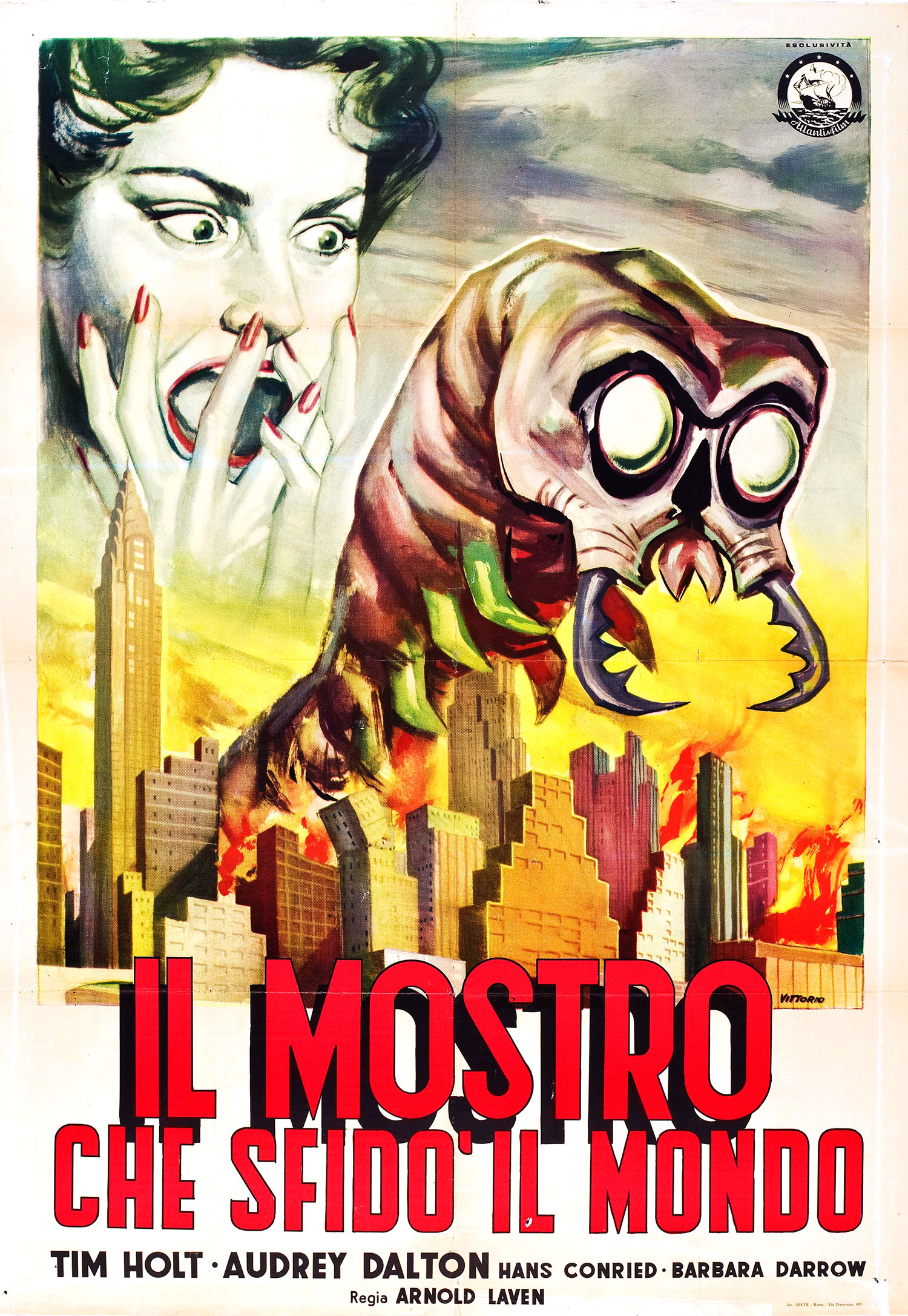Having done The October Horrorshow Giant Monstershow last year, and now It Came from the ’50s this year, I have become more familiar with 1950s monster flicks than I ever thought possible. For good or bad, I know the differences between a Bert I. Gordon flick and a W. Lee Wilder shitfest. I’ve seen short ties and high waists. I’ve seen an endless procession of Stepford Wives clones, and a fair amount of casual misogyny. I’ve seen the arts of stop motion photography and papier-mâché used, abused, and taken to their absolute limits of usefulness. I’ve also seen the same plot and character tropes used over and over and over again. By the time today’s film, The Monster that Challenged the World, was released, in 1957, it looked as if these films were done by rote, with no regard for originality.
The Monster that Challenged the World isn’t a bad film, even though it is shitty. In fact, it has wonderful moments of shittiness. But its 83-minute running time, about 15-20 minutes longer than contemporary monster fare, feels longer than it is. It takes all the well-worn stuff from all previous monster flicks and stretches it out. Sometimes, more isn’t better. It’s a simple lesson that producers Arthur Gardner and Jules V. Levy, and director Arnold Laven, would have done well to heed.
From a screenplay by Pat Fielder, Monster is about a previously unknown species of giant mollusk that surfaces in the Salton Sea after an earthquake opens an underwater fissure. The mollusks are a kind of prehistoric snail that is grown to epic proportions, with shells the size of a washing machine, and a hideous visage more reminiscent of spiders than snails.
The US Navy, for reasons explained in a lengthy introductory narration, are conducting parachute experiments over the lake, when one of the creatures attacks a parachutist and his recovery crew. The creature feeds on the humans, sucking the liquid from their bodies and leaving behind a shriveled corpse.
The monster is fairly gross, pushing the limits of ickiness in a monster flick for the time. It’s still just a giant puppet, and, like most monster flicks, there wasn’t much of a budget to speak of, so nothing about the creature is convincing, but at least it’s nasty-looking.  As for its victims…They resemble ventriloquist dummies or marionettes more than anything else. It’s hard to work up empathy for one of the victims when the corpse prop looks like its next destination is the set of The Thunderbirds.
As for its victims…They resemble ventriloquist dummies or marionettes more than anything else. It’s hard to work up empathy for one of the victims when the corpse prop looks like its next destination is the set of The Thunderbirds.
Monster stars Tim Holt as Lt. Cmdr. John ‘Twill’ Twillinger, the commander of the small naval contingent on the lake. After the initial attack on his personnel, Twill will not rest until he finds out what happened. Twill enlists the help of research scientists Dr. Jess Rogers (comedic actor Hans Conried), Dr. Tad Jones (Max Showalter), and Dr. George Blake (Dennis McCarthy). It takes the entire first act, but the Navy eventually finds out what audiences already know: There are giant monsters attacking people. And, left unchecked, they could take over the world!
The second and third acts are all about hunting and killing the beasts. Throw in a love interest for Twill in the form of Rogers’s secretary, Gail MacKenzie (Audrey Dalton), make sure she becomes the damsel in distress at some point, and we have every giant monster flick that has come before. I hate to sound so jaded, but ’50s giant monster flicks were even more formulaic than ’80s and ’90s buddy cop flicks, and there were more giant monster flicks made. Why wouldn’t there be, when a studio or independent production company could shoot one of these puppies in about two weeks, or even less?
The Monster That Challenged the World is far from the worst example of ’50s monster fare, but it’s a movie that heavily rewards ignorance. One has to go into this film with little knowledge of the genre, otherwise its familiarity becomes a test of patience. Had the filmmakers been more skilled as storytellers, they could have overcome the familiar. After all, originality has never been a requirement or predictor of success in Hollywood. But, Laven and company were not able to make this film more interesting than any of the others that are so like it.
For the sins of dullness and wallowing in overused tropes, this otherwise serviceable film is cast into the depths of the Watchability Index, landing #137, in between the 2008 remake of The Eye and Galaxy of Terror. I watched it, so you don’t have to.
